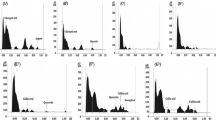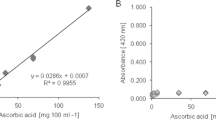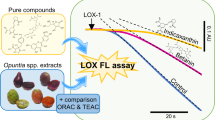Abstract
Substantial evidence exists to support the hypothesis that high fruit and vegetable consumption, rich in antioxidants, can reduce the incidence of several disease states. The aim of this study was to compare the results obtained by six spectrophotometric biochemical methods including the ferric reducing antioxidant power (FRAP), 2, 2-diphenyl-1-picryhydrazyl (DPPH•), 2,2-azinobis-3-ethylbenzothiazoline-6-sulfonic acid (ABTS•+), copper (II) reducing capacity (CUPRAC) and Cerium (IV) reducing antioxidant capacity (CERAC) assays as well as Folin-Ciocalteu method (FC) for the measurement of total antioxidant capacity (TAC) and total polyphenols (TP) in different commercially available vegetable juices. There was a significant positive correlation between the results obtained for FRAP, ABTS•+, CUPRAC, CERAC and FC (0.68 ≤ r ≤ 0.96, P < 0.01). DPPH• was only correlated with CERAC (r = 0.66, P < 0.01). Beetroot juice had the highest TAC and TP regardless of the method of analysis.
Similar content being viewed by others
Abbreviations
- ABTS:
-
2,2-Azino-bis-3-ethylbenzothiazoline-6-sulfonic acid
- CERAC:
-
Cerium IV reducing antioxidant capacity
- CUPRAC:
-
Copper II reducing antioxidant capacity
- DPPH:
-
2 2-diphenyl-1-picryhydrazyl
- FAE:
-
Ferulic acid equivalents
- FC:
-
Folin-Ciocalteu method
- FRAP:
-
Ferric reducing antioxidant power
- HAT:
-
Hydrogen atom transfer
- RONS:
-
Reactive oxygen and nitrogen species
- SET:
-
Single electron transfer
- TAC:
-
Total antioxidant capacity
- TE:
-
Trolox equivalents
- TP:
-
Total polyphenols
- Trolox:
-
6-hydroxy-2,5,7,8-tetramethylchromane-2-carboxylic acid
References
Boffetta P, Couto E, Wichmann J, Ferrari P, Trichopoulos D, Bueno-de-Mesquita HB et al (2010) Fruit and vegetable intake and overall cancer risk in the european prospective investigation into cancer and nutrition (EPIC). J Natl Cancer Inst 102(8):529–537
Ellingsen I, Hjerkinn EM, Seljeflot I, Arnesen H, Tonstad S (2008) Consumption of fruit and berries is inversely associated with carotid atherosclerosis in elderly men. Br J Nutr 99(3):674–681
Commenges D, Scotet V, Renaud S, Jacqmin-Gadda H, Barberger-Gateau P, Dartigues JF (2000) Intake of flavonoids and risk of dementia. Eur J Epidemiol 16(4):357–363
de Rijk MC, Breteler MM, den Breeijen JH, Launer LJ, Grobbee DE, van der Meche FG, Hofman A (1997) Dietary antioxidants and Parkinson disease. The rotterdam study. Arch Neurol 54(6):762–765
Sauvaget C, Nagano J, Allen N, Kodama K (2003) Vegetable and fruit intake and stroke mortality in the Hiroshima/Nagasaki life span study. Stroke 34(10):2355–2360
Webb AJ, Patel N, Loukogeorgakis S, Okorie M, Aboud Z, Misra S, Rashid R, Miall P, Deanfield J, Benjamin N, MacAllister R, Hobbs AJ, Ahluwalia A (2008) Acute blood pressure lowering, vasoprotective, and antiplatelet properties of dietary nitrate via bioconversion to nitrite. Hypertension 51(3):784–790
Carter P, Gray LJ, Troughton J, Khunti K, Davies MJ (2010) Fruit and vegetable intake and incidence of type 2 diabetes mellitus: Systematic review and meta-analysis. Br Med J (Clin Res Ed) 341:c4229
He K, Hu FB, Colditz GA, Manson JE, Willett WC, Liu S (2004) Changes in intake of fruits and vegetables in relation to risk of obesity and weight gain among middle-aged women. Int J Obes Relat Metab Disord 28(12):1569–1574
Suido H, Tanaka T, Tabei T, Takeuchi A, Okita M, Kishimoto T, Kasayama S, Higashino K (2002) A mixed green vegetable and fruit beverage decreased the serum level of low-density lipoprotein cholesterol in hypercholesterolemic patients. J Agric Food Chem 50(11):3346–3350
Dauchet L, Amouyel P, Dallongeville J (2009) Fruits, vegetables and coronary heart disease. Nat Rev Cardiol 6(9):599–608
Cho EY, Seddon JM, Rosner B, Willett WC, Hankinson SE (2004) Prospective study of intake of fruits, vegetables, vitamins and carotenoids and risk of age-related maculopathy. Arch Ophthalmol 122(6):883–892
Paredes-Lopez O, Cervantes-Ceja ML, Vigna-Perez M, Hernandez-Perez T (2010) Berries: improving human health and healthy aging, and promoting quality life—A review. Plant Foods Hum Nutr 65(3):299–308
Huang D, Ou B, Prior RL (2005) The chemistry behind antioxidant capacity assays. J Agric Food Chem 53(6):1841–1856
Benzie IF, Strain JJ (1996) The ferric reducing ability of plasma (FRAP) as a measure of “antioxidant power”: The FRAP assay. Anal Biochem 239(1):70–76
Ozyurt D, Demirata B, Apak R (2010) Modified cerium(IV)-based antioxidant capacity (CERAC) assay with selectivity over citric acid and simple sugars. J Food Comp Anal 23(3):282–288
Apak R, Guclu K, Ozyurek M, Karademir SE (2004) Novel total antioxidant capacity index for dietary polyphenols and vitamins C and E, using their cupric ion reducing capability in the presence of neocuproine: CUPRAC method. J Agric Food Chem 52(26):7970–7981
Singleton VL, Orthofer R, Lamuela-Raventos RM (1999) Analysis of total phenols and other oxidation substrates and antioxidants by means of Folin-Ciocalteu reagent. Oxidants and Antioxidants, Pt A Methods Enzymol 299:152–178
Brand-Williams W, Cuvelier ME, Berset C (1995) Use of a free-radical method to evaluate antioxidant activity. Food Sci Tech - Leben-Wiss Tech 28(1):25–30
Ozgen M, Reese RN, Tulio AZ, Scheerens JC, Miller AR (2006) Modified 2,2-azino-bis-3-ethylbenzothiazoline-6-sulfonic acid (ABTS) method to measure antioxidant capacity of selected small fruits and comparison to ferric reducing antioxidant power (FRAP) and 2,2 '-diphenyl-1-picrylhydrazyl (DPPH) methods. J Agric Food Chem 54(4):1151–1157
Halliwell B (2011) Free radicals and antioxidants - quo vadis? Trends Pharmacol Sci 32(3):125–130
Singh PP, Chandra A, Mahdi F, Roy A, Sharma P (2010) Reconvene and reconnect the antioxidant hypothesis in human health and disease. Int J Clin Biochem 25(3):225–243
Virgili F, Marino M (2008) Regulation of cellular signals from nutritional molecules: A specific role for phytochemicals, beyond antioxidant activity. Free Radic Biol Med 45(9):1205–1216
Szajdek A, Borowska EJ (2008) Bioactive compounds and health-promoting properties of berry fruits: A review. Plant Foods Hum Nutr 63(4):147–156
Wootton-Beard PC, Moran A, Ryan L (2011) Stability of the antioxidant capacity and total polyphenol content of 23 commercially available vegetable juices before and after in vitro digestion as measured by FRAP, DPPH, ABTS and Folin-Ciocalteu methods. Food Res Int 44(1):217–224
Butera D, Tesoriere L, Di Gaudio F, Bongiorno A, Allegra M, Pintaudi AM, Kohen R, Livrea MA (2002) Antioxidant activities of Sicilian prickly pear (Opuntia ficus indica) fruit extracts and reducing properties of its betalains: Betanin and indicaxanthin. J Agric Food Chem 50(23):6895–6901
Tesoriere L, Allegra M, Butera D, Livrea MA (2004) Absorption, excretion, and distribution of dietary antioxidant betalains in LDLs: Potential health effects of betalains in humans. Am J Clin Nutr 80(4):941–945
Pavlov A, Kovatcheva P, Tuneva D, Ilieva M, Bley T (2005) Radical scavenging activity and stability of betalains from Beta vulgaris hairy root culture in simulated conditions of human gastrointestinal tract. Plant Foods Hum Nutr 60(2):43–47
Georgiev VG, Weber J, Kneschke EM, Denev PN, Bley T, Pavlov AI (2010) Antioxidant activity and phenolic content of betalain extracts from intact plants and hairy root cultures of the red beetroot Beta vulgaris cv. detroit dark red. Plant Foods Hum Nutr 65(2):105–111
Lichtenthaler R, Marx F (2005) Total oxidant scavenging capacities of common European fruit and vegetable juices. J Agric Food Chem 53(1):103–110
Lugasi A, Hovari J (2003) Antioxidant properties of commercial alcoholic and nonalcoholic beverages. Nahrung-Food 47(2):79–86
Świderski F, Żebrowska M, Sadowska A (2009) The antioxidant capacity and polyphenol content of organic and conventially marked vegetable juices. Warsaw School of Management. http://www.wsm.warszawa.pl/index.php/uczelnia/czasopismo-naukowe. 2
Benzie IFF, Szeto YT (1999) Total antioxidant capacity of teas by the ferric reducing/antioxidant power assay. J Agric Food Chem 47(2):633–636
Sreeramulu D, Raghunath M (2010) Antioxidant activity and phenolic content of roots, tubers and vegetables commonly consumed in India. Food Res Int 43(4):1017–1020
Tezcan F, Gultekin-Ozguven M, Diken T, Ozcelik B, Erim FB (2009) Antioxidant activity and total phenolic, organic acid and sugar content in commercial pomegranate juices. Food Chem 115(3):873–877
Aoshima H, Ayabe S (2007) Prevention of the deterioration of polyphenol-rich beverages. Food Chem 100:350–355
Acknowledgments
The authors wish to acknowledge the support of Professor David Fell during this study. The mention of product or brand names in this article are for the purposes of giving specific information only and do not imply any endorsements or recommendations by the Functional Food Centre, Oxford Brookes University. The authors report no conflict of interest, financial or otherwise.
Author information
Authors and Affiliations
Corresponding author
Rights and permissions
About this article
Cite this article
Wootton-Beard, P.C., Ryan, L. Combined use of Multiple Methodologies for the Measurement of Total Antioxidant Capacity in UK Commercially Available Vegetable Juices. Plant Foods Hum Nutr 67, 142–147 (2012). https://doi.org/10.1007/s11130-012-0287-z
Published:
Issue Date:
DOI: https://doi.org/10.1007/s11130-012-0287-z




